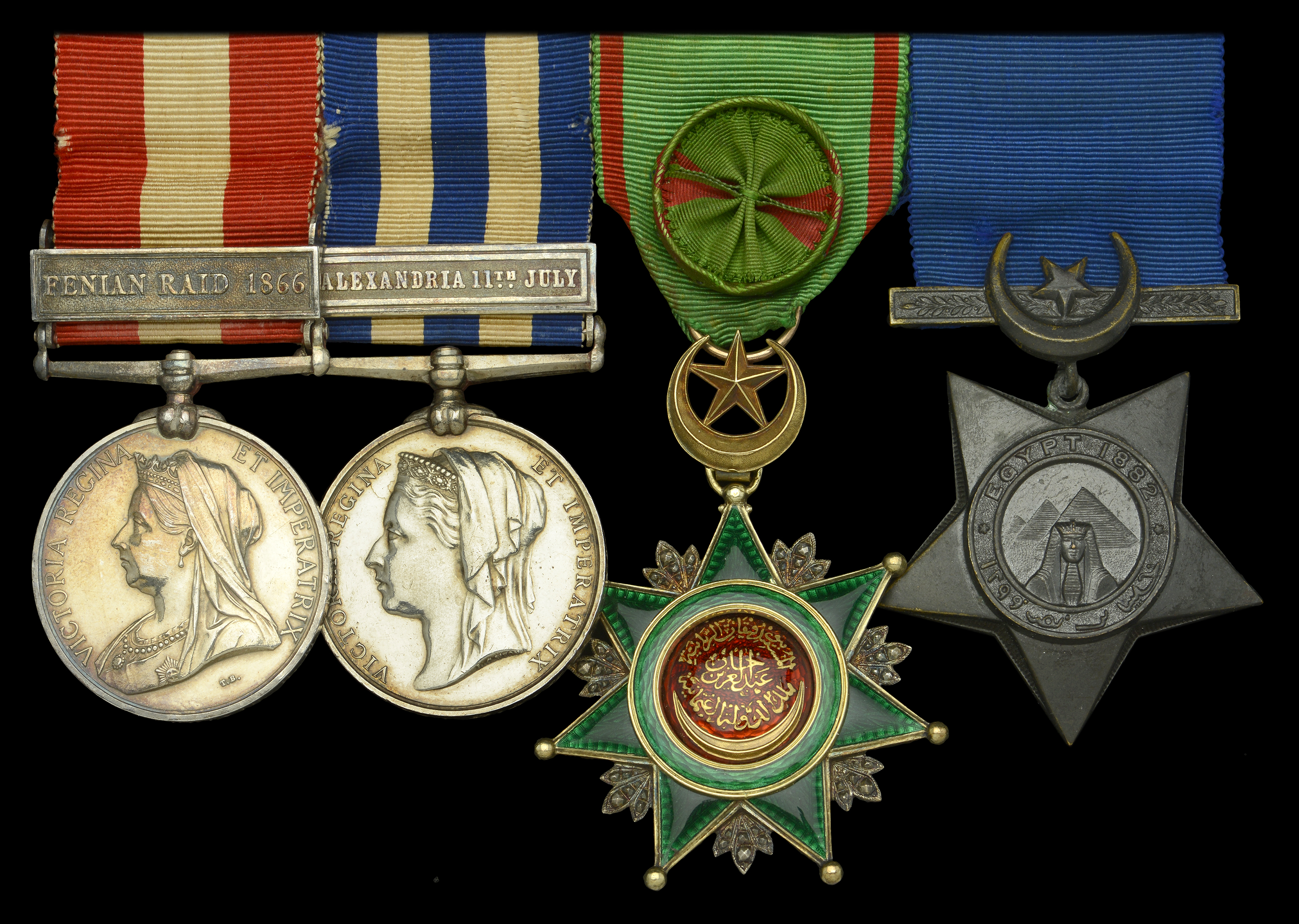The rare Victorian campaign group of four awarded to Captain C. K. Purvis, Royal Navy, who commanded an ‘armoured train’ in the action at Kassassin, in which he was severely wounded Canada General Service 1866-70, 1 clasp, Fenian Raid 1866 (Midshipman C. K. Purvis, H.M.S. Fawn) officially impressed naming; Egypt and Sudan 1882-89, dated reverse, 1 clasp, Alexandria 11th July (Lieut. C. K. Purvis, R.N. H.M.S. “Penelope”); Ottoman Empire, Order of Osmanieh, 4th Class breast badge, silver-gilt, gold and enamels; Khedive’s Star, dated 1882, mounted as worn, nearly extremely fine (4) £3,000-£4,000 --- Importation Duty This lot is subject to importation duty of 5% on the hammer price unless exported outside the UK --- --- Provenance: Douglas-Morris Collection, Dix Noonan Webb, October 1996; Dix Noonan Webb, June 2006. Only seven ‘Fenian Raid 1866’ clasps to H.M.S. Fawn. Charles Kennedy Purvis was born on 26 September 1849 and entered the Royal Navy as a Cadet in Britannia in March 1863. Appointed a Midshipman in H.M.S. Fawn in December 1864, he remained likewise employed for two years and witnessed active service off Canada in the Fenian operations in 1866. He subsequently gained advancement to Sub. Lieutenant in the Royal Oak in June 1869 and to Lieutenant in the Topaze in September 1873, followed by further seagoing appointments in the Hornet in 1875-80 and the Penelope in 1881-82. And it was from the latter ship that he was landed for special service in the Egypt operations, with command of one of the two ‘armoured trains’ deployed in the Egyptian war zone. In reality these were no more than an armed truck, one being manned by seamen and the other by marines. The bluejackets’ four-wheeled gun-truck, commanded by Lieutenant Purvis, had steel-plated sides that were ‘fairly bullet proof’, with sandbags hung around the outside for good measure. An awning was added over the truck’s open top and it was armed with a 40-pounder gun. A separate box-car, similarly fitted with steel side plates and sandbags, had two compartments for the 230 shells - mostly shrapnel - and charges, entrance to each magazine being only from the top. Since no steam engines could be obtained, Purvis’s naval train was pulled from Ismailia to Nefiche by 16 horses, four abreast, on 26 August 1882. On 1 September, Purvis and his train moved up to Kassassin where, on the 9th, he and his 20-strong party of bluejackets saw action in the defence of the camp against an Egyptian reconnaissance party. Having been working the train on the line a little beyond the camp, the enemy turned their guns on it. Purvis and his 2nd in Command, Sub. Lieutenant James Erskine, dismounted to take some observations. They were standing close together when a shell burst near them, a small portion of which struck Purvis on the foot, tearing a portion of it off, and necessitating immediate amputation at the ankle joint. Subsequently, to rub salt into his wounds, while on his way to Ismailia to be placed aboard the Orontes, he was struck by a tow rope which brought on inflammation and made a second amputation above the ankle imperative. On a somewhat happier note, on Christmas Eve 1882, Purvis was one of two officers in the R.N. Hospital Haslar to receive their Egypt campaign medals from the hand of Queen Victoria. Moreover, he received special promotion to Commander and was mentioned in General Sir Garnet Wolseley’s despatch in the following terms: ‘In command of detachment working 40-pounder on truck; regrets very much the loss of his valuable services.’ Discharged from Haslar in January 1883, Purvis joined the Coast Guard but he returned to sea with command of the Flora in 1887-89. His final appointment was in the harbour based Audacious and he was placed on the Retired List as a Captain in October 1896. He died on 2 June 1916.





